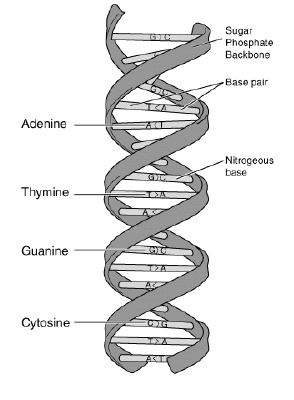UVa 1368 DNA Consensus String(DNA序列)
来源:互联网 发布:离线翻译软件哪个好 编辑:程序博客网 时间:2024/05/18 01:50
Description
 Figure 1.
Figure 1.
``Thymine-Adenine-Adenine-Cytosine-Thymine-Guanine-Cytosine-Cytosine-Guanine-Adenine-Thymine"
Then we can represent the above DNA strand with the string ``TAACTGCCGAT." The biologist Prof. Ahn found that a gene X commonly exists in the DNA strands of five different kinds of animals, namely dogs, cats, horses, cows, and monkeys. He also discovered that the DNA sequences of the gene X from each animal were very alike. See Figure 2.
Prof. Ahn thought that humans might also have the gene X and decided to search for the DNA sequence of X in human DNA. However, before searching, he should define a representative DNA sequence of gene X because its sequences are not exactly the same in the DNA of the five animals. He decided to use the Hamming distance to define the representative sequence. The Hamming distance is the number of different characters at each position from two strings of equal length. For example, assume we are given the two strings ``AGCAT" and ``GGAAT." The Hamming distance of these two strings is 2 because the 1st and the 3rd characters of the two strings are different. Using the Hamming distance, we can define a representative string for a set of multiple strings of equal length. Given a set of strings S = s1,...,sm of length n , the consensus error between a string y of length n and the set S is the sum of the Hamming distances between y and eachsi in S . If the consensus error between y and S is the minimum among all possible strings y of length n , y is called a consensus string of S. For example, given the three strings `` AGCAT" `` AGACT" and `` GGAAT" the consensus string of the given strings is `` AGAAT" because the sum of the Hamming distances between `` AGAAT" and the three strings is 3 which is minimal. (In this case, the consensus string is unique, but in general, there can be more than one consensus string.) We use the consensus string as a representative of the DNA sequence. For the example of Figure 2 above, a consensus string of gene X is `` GCAAATGGCTGTGCA" and the consensus error is 7.
Input
Your program is to read from standard input. The input consists of T test cases. The number of test cases T is given in the first line of the input. Each test case starts with a line containing two integers m and n which are separated by a single space. The integer m(4Output
Your program is to write to standard output. Print the consensus string in the first line of each case and the consensus error in the second line of each case. If there exists more than one consensus string, print the lexicographically smallest consensus string. The following shows sample input and output for three test cases.Sample Input
3 5 8 TATGATAC TAAGCTAC AAAGATCC TGAGATAC TAAGATGT 4 10 ACGTACGTAC CCGTACGTAG GCGTACGTAT TCGTACGTAA 6 10 ATGTTACCAT AAGTTACGAT AACAAAGCAA AAGTTACCTT AAGTTACCAA TACTTACCAA
Sample Output
TAAGATAC 7 ACGTACGTAA 6 AAGTTACCAA 12
说实话一开始真的是没看明白这题啥意思,光知道这是一大堆碱基对,然后觉得自己生物学得一级棒就直接看示例。。。但事实证明真的还是需要看题干啊!!后来仔细地体会了一下题意,意思就是说找出跟给出几组DNA序列最相近相似的DNA序列(有点像亲子鉴定啊Orz。。。),其实就是求出一个序列,到所有给定序列的总“Hamming”距离最小,Hamming距离指的是两个等长字符串对应位置的字符不同数,比如ACGT和TCGA的距离就为2,所以问题就很明了了,把给定的序列排好了,存进二维数组,每一列的最优解就是每一列出现最多的字符,如果有字符出现次数相同的情况,则按照a,c,g,t顺序来。题目逻辑很清晰,先逐列再逐行扫描,统计出每一列的最多的字符,然后取字符为当前列最优解,并统计Hamming距离,最后注意对分支条件的控制就可以了,可大大压缩代码量,代码如下:
#include <iostream>using namespace std;int main(){int test,n,m,cont,i,j;int a,c,g,t;char puzzles[60][1111];char str[1111];cin>>test;while(test--){cont=0;cin>>n>>m;for(i=0;i<n;i++)cin>>puzzles[i];for(i=0;i<m;i++){a=c=g=t=0;for(j=0;j<n;j++){switch(puzzles[j][i])//统计当前列各字符的个数{case 'A':a++;break;case 'C':c++;break;case 'G':g++;break;case 'T':t++;break;}}if(a>=c&&a>=g&&a>=t)//这个多分支结构的顺序以及每个分支里逻辑的顺序很重要,刚好可以表达出现相等字符时按照acgt的顺序{str[i]='A';cont+=n-a;//统计Hamming距离,行数-最优碱基的个数}else if(c>=a&&c>=g&&c>=t){str[i]='C';cont+=n-c;}else if(g>=a&&g>=c&&g>=t){str[i]='G';cont+=n-g;}else{str[i]='T';cont+=n-t;}}str[i]=0;//因为这个数组是逐字赋值,所以别忘了加上字符串结束标志cout<<str<<endl<<cont<<endl;}return 0;}- UVa 1368 DNA Consensus String (DNA序列)
- DNA序列(DNA Consensus String, UVa 1368)算法
- UVa 1368 DNA Consensus String(DNA序列)
- uva 1368 DNA Consensus String(检索)
- uva 1368 - DNA Consensus String(贪心)
- uva - 1368 - DNA Consensus String(字符串)
- UVa 1368 - DNA Consensus String(贪心)
- uva 1368 - DNA Consensus String(贪心)
- (入门)uva 1368 DNA Consensus String
- UVA 1368 - DNA Consensus String
- uva 1368 DNA Consensus String
- Uva-1368-DNA Consensus String
- UVa 1368 DNA Consensus String
- UVA 1368 DNA Consensus String
- UVA 1368 DNA Consensus String
- UVa:1368 DNA Consensus String
- uva 1368 - DNA Consensus String
- UVa 1368 - DNA Consensus String
- 家乡的南城区,也开始建一些基础设施了。
- git@osc使用
- POJ 3241 Object Clustering 莫队算法
- [SetContextPropertiesRule]{Context} Setting property 'source'
- C++实现基于离散Hopfield神经网络噪声数字的识别_智能计算作业三
- UVa 1368 DNA Consensus String(DNA序列)
- Longest Substring Without Repeating Characters
- SDL2.0例子代码分析---代码运行平台检测
- 如何去掉ios8.1下的button下划线
- HDOJ 今年暑假不AC 2037
- 关于Action中ValidateXXX方法校验一次失败后\导致以后一直返回input视图的情况
- cheap louis vuitton pIRJ YAWE kprxm
- HDOJ EXCEL排序 1862(sort排结构体)
- 我的互联网时代(一)


